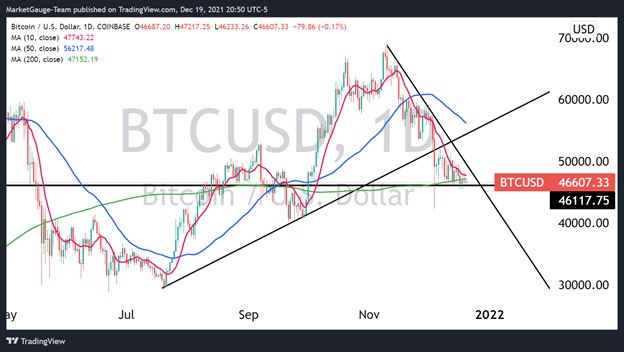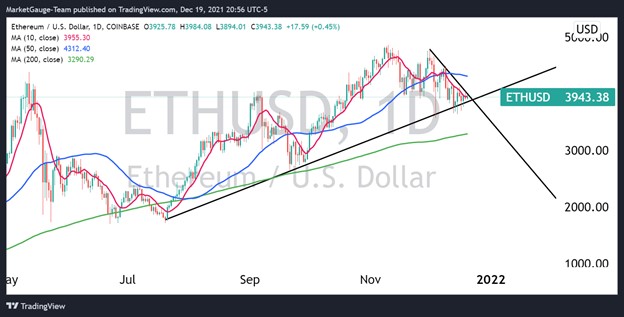
This week we are only going to focus on two charts, one of Bitcoin (BTC) and one of Ethereum (ETH). With the exception of a few outliers like Avalanche (AVAX) and Terra (LUNA), Bitcoin and Ethereum have been leading the general downtrend of the cryptocurrency market since they reached new all-time highs in early November.
First things first, Bitcoin has unfortunately violated its long-term trend that was established in Mid-July, but we still may have an interesting (and potentially bullish) chart pattern forming in the short-term.

Bitcoin has also now seen 3 consecutive daily closes below its 200-day moving average. The one glaring positive for Bitcoin here is the consolidation wedge pattern that has seen support maintained just above the $46,000 level. At the moment, this is the level that needs to be protected, otherwise a drawdown to $42,000 is almost certain.
A much stronger looking trend that is still intact is Ethereum’s trend that was also established in July 2021.

Interestingly, we also have a downward trend for Ethereum that has not been broken since topping out at $4,784 on December 1st. As of Sunday night, we are seeing Ethereum’s price consolidation running right into the cross between the coins long and short-term trends, a potential opportunity for a breakout back above the $4,000 level.
Bitcoin and Ethereum continue to be the two best benchmarks for the cryptocurrency market, with a combined 61.5% dominance of the total crypto market cap. At the moment, it looks like Ethereum will continue along its longer-term trend and attempt to set new highs in Q1 of 2022.
With Ethereum looking likely to lead the market for the foreseeable future, it is the perfect time to start considering investing in altcoins that thrive in an ETH driven market.
Ethereum can be included in several categories or subsectors of the cryptocurrency industry, but the best way to refer to ETH is as a Layer 1.
Layer 1’s are blockchains that are established as the base layer of a large decentralized network, with the capabilities of scaling the overall network by supporting other services built on top of the base blockchain layer. Any cryptocurrency, service or product built using a Layer 1 blockchain is referred to as a Layer 2.
Ethereum is the world’s largest Layer 1 decentralized finance network. This means that Ethereum’s blockchain is used all over the world by developers that are creating their own cryptocurrencies and decentralized services.
The largest Layer 2 that exists on the Ethereum blockchain is likely Polygon (MATIC). Polygon is essentially a clone of the Ethereum blockchain that is able to support transactions and data storage that would take up too much space on the main Ethereum blockchain. This is important, as Layer 2’s like Polygon allow for Ethereum to continue supporting a global inflow of network functions without becoming oversaturated and slow.
Layer 2’s can range from decentralized financial services for trading, banking and lending, as well as NFTs and blockchain based video games.
Blockchains enable the existence of Layer 1’s and Layer 2’s that are currently building the foundation of what is becoming known as ‘Web3’, or the new version of the internet. The theory behind Web3 is that Web2 saw the centralization of personal data by a handful of major internet and technology companies commonly known as ‘Big Tech’, and with the decentralization of user data through blockchain technology, we will establish a more secure and transparent version of the internet.
Some other popular Layer 1’s include Solana (SOL), Avalanche (AVAX), Terra (LUNA), and Binance Smart Chain (BSC). These are all coins that operate their own base level blockchain network with the ability for other cryptocurrencies and defi projects to be built within their ecosystem.
At MarketGauge we are big fans of Solana, as it has the fastest transaction times with the lowest transaction fees of any other Layer 1 defi network that we’ve seen.
Whether you are a novice crypto trader or have been investing in cryptocurrencies for several years, we would like to invite you to learn more about this topic at our CryptoPulse live mentoring session at 2:00 pm ET this Wednesday 12/22.
We will be discussing Crypto Industry Best Practices including how to safely create a new cryptocurrency wallet, how to access and use Web3 defi services, and show you examples of some of our favorite Layer 2 cryptocurrencies you’ve likely never heard of before!
If you are already registered for the CryptoPulse service then you already have access to the Wednesday session. If you are not yet a CryptoPulse subscriber, due to this week's mentoring opportunity, we've extended the opportunity to get in here.